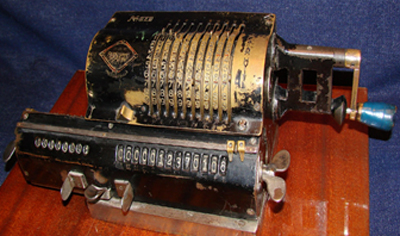Statistical Calculation Tools: 1893-1915
What tools, machines, tabulations sheets etc. were used by Tallman and his students
for calculating the sums of squares and cross products necessary for finding least
squares solutions, correlations, etc.? Engineers and scientists had been using tables
of logarithms for many years. By 1893, “a 12-digit arithmometer sold for about 30
times the price of a table of logarithms book, but, unlike a table of logarithms book,
it was simple enough to be used for hours by an operator without any special qualifications.
The arithmometer could add and subtract two numbers directly and could perform long
multiplications and divisions effectively by using a movable accumulator for the result.
Patented in France by Thomas de Colmar in 1920, it became the first commercially successful
mechanical calculator. ... Its production launched the mechanical calculator industry
which ultimately built millions of machines until the 1970s.”3

Arithmometer, circa 1907
The first Monroe hand-cranked rotary calculators of the type we “cut our teeth on” in the 1950s had been available since about 1911. Would such have been used at MSC in the early 1900s? The arithmometer (early version shown in the Figure) was imitated by many manufacturers and called by different names. Many thousands were manufactured by 1914. Later on, mechanisms were operated by small electric motors. Perhaps MSC could afford some of these machines.
A partial generic answer to our calculation questions is provided in W. I. King’s
1915 textbook, where the stated expenses are in 1915 dollars (multiply by 24 to convert
to 2017 dollars). “The statistician will find that certain mechanical aids are essential
if he is to do much actual statistical work. For operations in which it is not desired
to attain greater accuracy than three digits, small slide rules costing from $2.75
to $21.50 are very satisfactory. A Fuller spiral slide rule, price $30.00, is very
convenient in multiplication and division and the results may be read correctly to
five digits. The Thacher cylindrical slide rule costing $35.00 is slightly less convenient
but has the additional merit of giving squares and square roots directly. Its accuracy
is the same as that of the Fuller. If it is necessary to have exact results in multiplication
or division, an arithmometer or reckoning machine is very desirable. These cost from
$193 to $338. ... An adding machine is almost essential if a large amount of adding
is to be done. The most complete ones are sold by the Burroughs Adding Machine Co.
... at from $325 up.”6
Era 3 (MSC Statistics Program)
Table of Contents
(Last revised: 2021-08-31)
